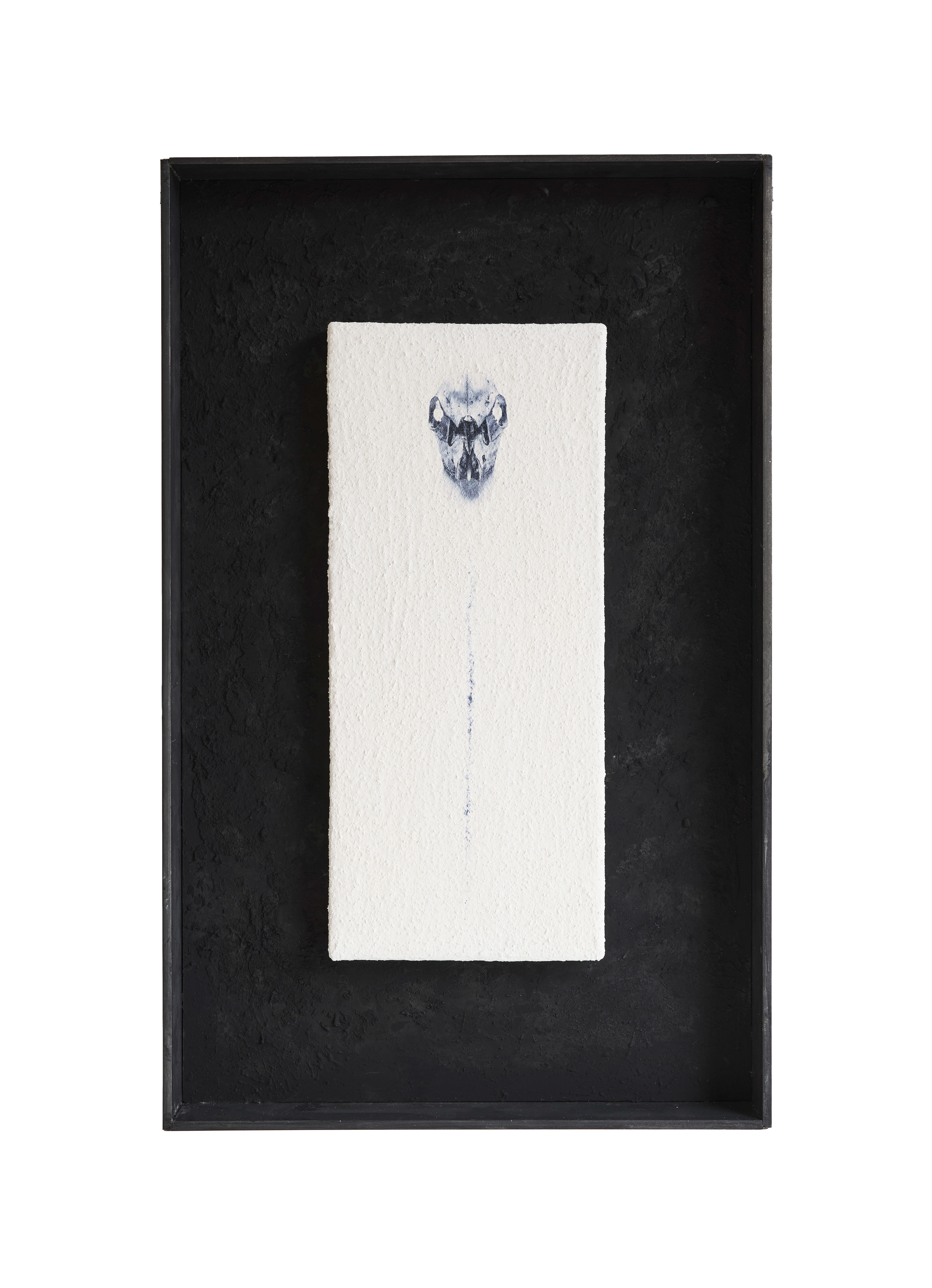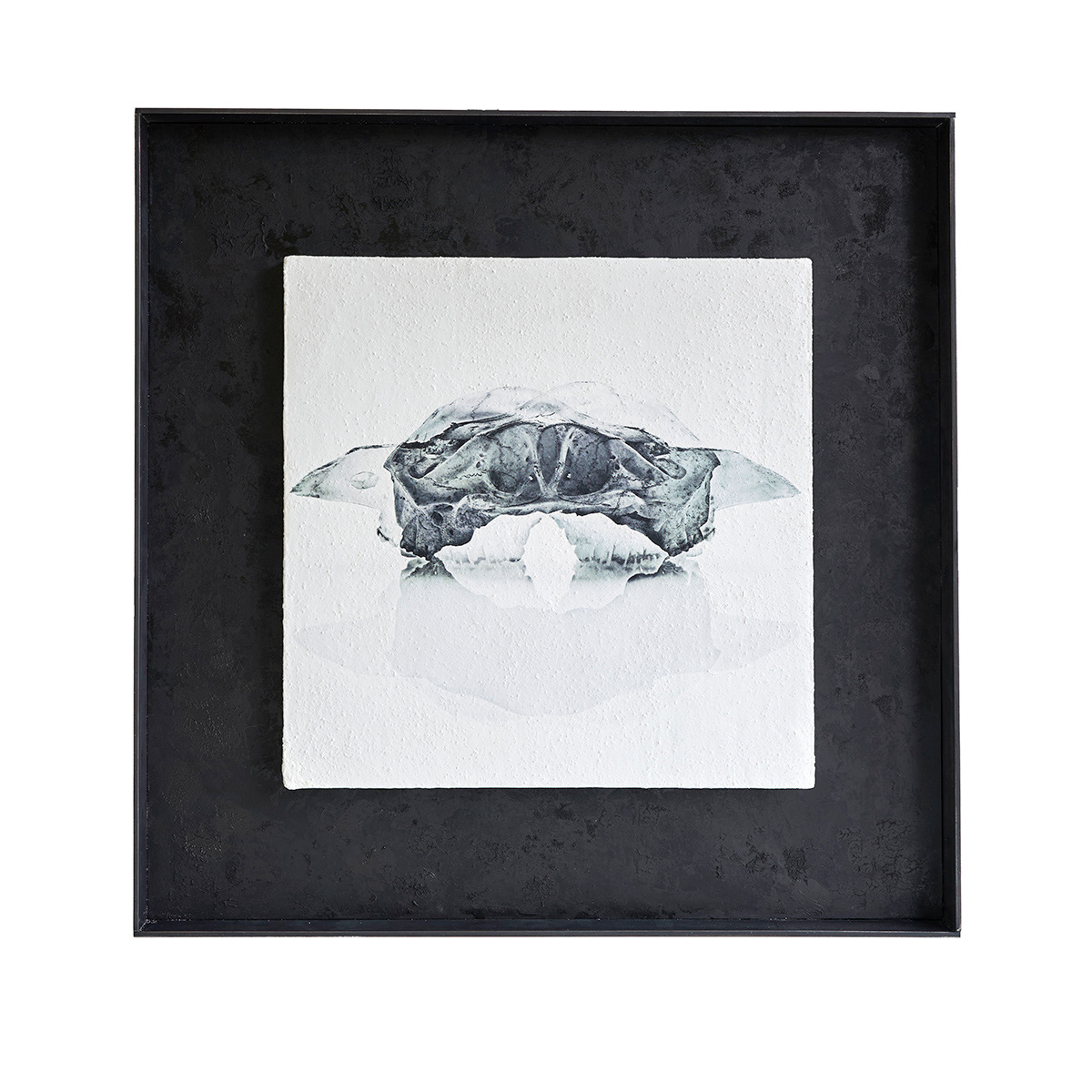From postwar reconstruction through rapid economic growth, Japan promoted swift afforestation and urbanization. The satoyama buffer zones vanished. Since the 1990s, crop damage from wildlife has deepened. The 2007 Special Measures Act legalized "culling," with tens of millions of animals now eliminated annually.
Bears, deer, boars, monkeys―they were simply living as before. What became "damage" arose when humans unilaterally drew boundaries and expanded their territories from the Jomon period onward.
The bones in this work are remains of lives extinguished by this killing system―proof of existence and traces of an environmental cycle I witnessed.
In wall pieces, I embed countless bones beneath plaster layers. The white film of forgetting eventually cracks, revealing black shadows―traces of beings that society tried to process with the term "pest control." Perhaps this is what we might call "the presence of absence."
In hourglass works, bones become time particles marking extinguished lives and forest succession. In moss-planted bone pieces, I attempt transforming death into a cradle for next life. When water and light settle on bones, thin surfaces form. I imagine nurturing life within Earth's cycle, holding the broken ring quietly in human hands.
There was no reason for their existence to be called "damage." Yet we humans made it so.
戦後復興から高度経済成長期、日本は急速な森林開発と都市化を推進した。里山という緩衝地帯は失われ、生息域の境界は人間の都合で書き換えられた。1990年代以降の農作物被害深刻化を受け、2007年の鳥獣被害防止特措法により
「管理という名の殺戮」が法的に体系化され、現在年間数十万頭が駆除されている。
熊、鹿、猪、猿――彼らはただ生きていただけだった。縄文時代よりも前から共存してきた彼らが
「害獣」と呼ばれるようになったのは、人間が一方的に境界線を引き直し、森を伐り、田畑と住宅地を広げたからだ。
私たちが生態系のバランスを崩した結果、彼らの数は自然調整を超えて増加し、他の生物にも影響を及ぼしている。
シカの食害で下層植生が消え、イノシシの土壌攪乱、サルの樹皮剥ぎが森の再生を阻む。断たれた環りは連鎖する。
本作の骨は、その制度的殺戮で命を奪い、山に埋め、他の生命に食されたのちに残った遺骸だ。
彼らの生きた証であり、私たちが引いた境界線の痕跡でもある。
壁面作品では、漆喰の下に無数の骨を埋めている。白い忘却の膜がやがてひび割れ、黒い影がのぞく――社会が「害獣駆除」という言葉で処理しようとした存在の痕跡を見る。それは「不在の存在」とでも呼ぶような気配なのかもしれない。
砂時計の作品では、骨が時間の粒となり、失われた生命の時間、森の巡り、世代の継承を刻む。
そして骨に苔を植えた作品では、死を次の生への糧とする試みを行う。僅かな水と光で定着する原初の緑が、骨に薄い皮膚のような面を作る。あなたがその苔に水を与えるとき、地球の循環の中で私たち生物が皆生かされていることを想起する。
断たれた環りを人の手で繋ぎ直す静かな試みとして、この作品は存在する。
「害獣」と呼ばれる存在に、本来「害」である理由はなかった。
私たちが、そのような存在にしてしまったのだ。
戦後復興から高度経済成長期、日本は急速な森林開発と都市化を推進した。里山という緩衝地帯は失われ、生息域の境界は人間の都合で書き換えられた。1990年代以降の農作物被害深刻化を受け、2007年の鳥獣被害防止特措法により
「管理という名の殺戮」が法的に体系化され、現在年間数十万頭が駆除されている。
熊、鹿、猪、猿――彼らはただ生きていただけだった。縄文時代よりも前から共存してきた彼らが
「害獣」と呼ばれるようになったのは、人間が一方的に境界線を引き直し、森を伐り、田畑と住宅地を広げたからだ。
私たちが生態系のバランスを崩した結果、彼らの数は自然調整を超えて増加し、他の生物にも影響を及ぼしている。
シカの食害で下層植生が消え、イノシシの土壌攪乱、サルの樹皮剥ぎが森の再生を阻む。断たれた環りは連鎖する。
本作の骨は、その制度的殺戮で命を奪い、山に埋め、他の生命に食されたのちに残った遺骸だ。
彼らの生きた証であり、私たちが引いた境界線の痕跡でもある。
壁面作品では、漆喰の下に無数の骨を埋めている。白い忘却の膜がやがてひび割れ、黒い影がのぞく――社会が「害獣駆除」という言葉で処理しようとした存在の痕跡を見る。それは「不在の存在」とでも呼ぶような気配なのかもしれない。
砂時計の作品では、骨が時間の粒となり、失われた生命の時間、森の巡り、世代の継承を刻む。
そして骨に苔を植えた作品では、死を次の生への糧とする試みを行う。僅かな水と光で定着する原初の緑が、骨に薄い皮膚のような面を作る。あなたがその苔に水を与えるとき、地球の循環の中で私たち生物が皆生かされていることを想起する。
断たれた環りを人の手で繋ぎ直す静かな試みとして、この作品は存在する。
「害獣」と呼ばれる存在に、本来「害」である理由はなかった。
私たちが、そのような存在にしてしまったのだ。

Bone#007 2025 H22 × W22 × D22cm Bone, Wood, Glass, Moss, Kakishibu (persimmon tannin)

Bone#006 2025 H161.5 × W113 × D5cm "Charcoal, Lime plaster, Iron, Bone, Deer glue, Acrylic"

Bone#005 2025 H51.5 × W38 × D5cm "Charcoal, Bone, Lime plaster, Iron, UV print, Acrylic"

Bone Temporal#004 2025 "Hourglass HH15 × W5 × D5cm Pedestal H4 × W23 × D10cm" Bone, Glass, Karami-ishi (slag stone), Wood

Bone Temporal#003 2025 "Hourglass H8 × W 4 × D4cm Pedestal H3 × W10.5 × D5cm" "Bone, Glass, Karami-ishi (slag stone) "

Bone #002 2023 W 380 ×D 50 ×H 610mm Leaf, plaster, deer glue, deer bone, wood, iron, UV print Unique

